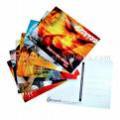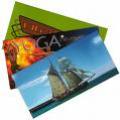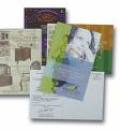
Post Cards Information Directory
|
A QUICK OVERVIEW OF POSTCARD COLLECTING
A Quick Overview Of Postcard Collecting
Post card collectors or more formally deltiologists, generally collect post cards for the view, subject depicted, topic, artist, publisher, photographer or any of hundreds of reasons relating to the front view of the post card. They are very much intrigued by the uniqueness and the view of a much simpler time in history.
The postal historian avidly seeks post cards for the stamp use, postmarks and postal markings, destinations and all the things related to the mailing or sending of the post card. Most of this information is generally found on the back of the card and the historian is unconcerned with the view or front of the card. This doesn't interest him at all.
The philatelist collects the card for the stamp used on a post card and the way the stamp is canceled. This is closely related in some ways for to the reasons a postal historian would collect post cards and maybe even for the same reason.
It does get a little touchy when trying to separate the differences between the postal historian and the philatelist. Postal history and philately have crossed over blurred lines since stamp collecting began. Generally a philatelist is concerned how a stamp is used, condition of the stamp and the way it is canceled. A cancel is the method of obliterating the stamp to prevent reuse.
A postal historian collects for the way a stamp is used and postmarked. A postmark is the way to determine the place and date the post card was sent from although postmarks are often used as cancellations.
So a deltiologist, or post card collector, collects because of the front of the card and information relating to the image on the card and in many cases prefers a pristine mint card. The postal historian, or cover collector, collects post cards for reasons on the back of the card and prefers a postal used post card. The philatelist, or stamp collector, collects the post card for the stamp on a used card.
A postal historian will sometimes use collateral material for exhibiting in their albums, displays or at competitive exhibitions. In addition, a real photo town view, especially of a " ghost " town, will be used as collateral along with a postmark from that town. This forms a pleasing combination for many postal historians. What is even better is when the town view is postmarked in the same town as in the view. This is an awesome find!
The deltiologist will also use a postmark as a crossover especially when their collecting cards from Worlds Fair and Expositions. The postmark from these special post offices can add great value to a post card and prove that it was purchased at the sight of the fair or exposition. These are also sought after items for the postal historian.
It makes no difference whether you collect post cards as a deltiologist, a postal historian or philatelist, the field is wide open. Collect what you like and how you like to collect! You can find them everywhere especially in old attics, garage sales and flea markets, antique shops and stamp shops, gas stations and hotels. Collecting Post Cards is a great hobby and one that can be passed on from generation to generation to share your past travels, interests and history with your family.
About The Author:
Peter Dobler is a veteran in the IT business. His passion for experimenting with new internet marketing strategies leads him to explore new niche markets.
Read more about his experience with post cards; visit http://post-cards.tip4u2.com
 |
 |
 |
HISTORY DESCRIPTION OF VINTAGE POSTCARDS
WHAT MAKES A POSTCARD VALUABLE
More Post Cards Reviews
... construction, elementary schools, picture of eggs and bacon from an obscure diner on some off the road place. There is even a book out called " Boring Postcards. There is a German title, " Langweilige Postkarten " that is even more evocative. It's a collection of meticulously grouped, carefully reproduced... ...
THE HISTORY OF EASTER POSTCARDS
... personified symbol of fruitfulness was often portrayed with eggs. German publishers were leading in the production of Easter postcards before the first world war. During the time of the first world war the children were replaced through soldiers and a military appearance of the Easter bunny was quite ...
HISTORY OF POSTCARDS...EARLY ERA
... publishers accounted for over 75 % of all postcards sold in the U. S. The popularity of lithographed cards caught Eastman - Kodak's attention as well. His company issued an affordable " Folding Pocket Kodak " camera around 1906. This enabled the mass public to take black & white photographs and have them ...
... Mucha and Raphael Kirchner. In Britain, Mabel Lucie Attwell's children, Alfred Quinton's landscapes, Louis Wain's cats, Tom Browne's ordinary people, and Donald McGill's henpecked husbands can all be found on cards. With such a wide choice of fascinating postcards to collect there really is plenty to ...

|
| Copyright © 2006-2012 Internet Marketing Tools, All Rights Reserved |